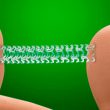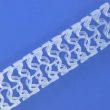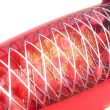Courtesy of Dr. Carlos Fava. Drug-eluting stents (DES) have shown mid-term benefit in lesions below the knee (BTK) by reducing the rate of acute occlusion and restenosis in type A and B lesions. However, failure to recover the self-regulatory functions of the local vessel could hinder future revascularization. Drug-eluting bioresorbable scaffolds (BVS) could be a solution to this problem....
BVS: Comparable to Second-Generation DES in Complex Lesions
A center carrying out a mid- to long-term follow-up of the performance of everolimus-eluting bioresorbable scaffolds (Absorb) observed that this new device has an acceptable rate of major cardiovascular events, when compared to second-generation drug-eluting stents. Furthermore, although the population was complex and non-selected, no cases of early thrombosis were reported. This study enrolled 249 patients...
BVS: Safe Also in Peripheral Territory
Original Title: Bioresorbable Everolimus-Eluting Vascular Scaffold for Patients With Peripheral Artery Disease (ESPRIT I) 2-Year Clinical and Imaging Results CME. Reference: Johannes Lammer et al. J Am Coll Cardiol Intv. 2016;9(11):1178-1187. This is the first study on humans to assess the bioresorbable everolimus eluting vascular scaffold for the treatment of peripheral artery disease involving...
Instent restenosis: Drug eluting balloons or drug eluting stents?
Original Title: Long-Term Results of Everolimus-Eluting Stents versus Drug-Eluting Balloons in Patients with Bare-Metal In-Stent Restenosis 3-Year Follow-Up of the RIBS V Clinical Trial. Reference: Alfonso F. et al. JACC Cardiovasc Interv. 2016 Jun 27;9(12):1246-55. Courtesy of Dr. Agustín Vecchia. RIBS V 3 year follow up Stents have become the gold standard for...
Chronic total occlusions: Pilot experience with BVS
Original Title: Percutaneous coronary intervention for chronic total occlusion of the coronary artery with implantation of bioresorbable everolimus-eluting scaffolds. Poznan CTO-Absorb Pilot Registry. Reference: Maciej Lesiak, et al EuroIntervention 2016;12:e144-e151 Courtesy of Dr. Carlos Fava. Chronic total occlusion (CTO) is a real challenge and have a success rate of around 80% with trained...
June 9, 2016
Rio de Janeiro, June 9, 2016. Another great day at Solaci/SBHCI 2016. Early this morning, the TCT/GI2@SOLACI session –Percutaneous Coronary Intervention– was conducted at Cristo Redentor room by Dr. Ajay Kirtane (USA), who talked about contemporary PCI. Following this event, Dr. Roxana Mehran (USA), delivered an excellent presentation on the evolution of stents and highlighted...
Stent thrombosis: Comparative analysis between BMS, DES and BRS
Original Title: Stent Thrombosis with Drug Eluting Stents and Bioresorbable Scaffolds. Evidence from a Network Meta-Analysis of 147 trials. Reference: Kang S et al. J Am Coll Cardiol Intv 2016 doi 10.1016. Courtesy of Dr. Guillermo Migliaro. When treating heart disease, drug eluting stents (DES) have become essential for PCI. Its main advantage lies on...
ABSORB EXTEND trial: preliminary report of clinical outcomes at 12 months in the first 512 patients
Original title: The ABSORB EXTEND Study: preliminary report of the twelve-month clinical outcomes in the first 512 patients enrolled. Reference: Alexandre Abizaid et al. EuroIntervention 2015;10:1396-1401. The safety and efficacy of the Absorb Bioresorbable Vascular Scaffold (Absorb BVS) has been previously shown in 131 patients of the ABSORB trial cohorts A and B. Following this trial, the prospective...
Successful CTO reduces local and remote residual ischemia
Courtesy of Dr. Carlos Fava. The presence of Chronic Total Occlusion (CTO) is about 30%, with an ischemic threshold between 10% and 12.5% to justify rechannelization. Using the new devices, the new guidelines and with more experience operators, these procedures are successful in 10% to 30% of cases. More often than not these patients are not treated...
BVS: Controvertial Scaffold
Courtesy of Dr. Agustín Vecchia. The advent of resorbable vascular scaffolds (BVS) generated high expectations among interventionists because of its potential advantages over bare metal stents. However, when comparing BVS against the Xience stent, we observed an increased rate of events associated to the first device, to their detriment. Among the reasons behind this poor...








